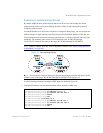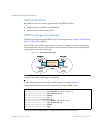
BMD00220, October 2010 303
CHAPTER 21
Protocol Independent Multicast
BLADEOS supports Protocol Independent Multicast (PIM) in Sparse Mode (PIM-SM) and Dense
Mode (PIM-DM).
Note – BLADEOS 6.5 does not support IPv6 for PIM.
The following sections discuss PIM support for the RackSwitch G8124:
“PIM Overview” on page 303
“Supported PIM Modes and Features” on page 304
“Basic PIM Settings” on page 305
“Additional Sparse Mode Settings” on page 308
“Using PIM with Other Features” on page 310
“PIM Configuration Examples” on page 311
PIM Overview
PIM is designed for efficiently routing multicast traffic across one or more IPv4 domains. This has
benefits for application such as IP television, collaboration, education, and software delivery, where
a single source must deliver content (a multicast) to a group of receivers that span both wide-area
and inter-domain networks.
Instead of sending a separate copy of content to each receiver, a multicast derives efficiency by
sending only a single copy of content toward its intended receivers. This single copy only becomes
duplicated when it reaches the target domain that includes multiple receivers, or when it reaches a
necessary bifurcation point leading to different receiver domains.
PIM is used by multicast source stations, client receivers, and intermediary routers and switches, to
build and maintain efficient multicast routing trees. PIM is protocol independent; It collects routing
information using the existing unicast routing functions underlying the IPv4 network, but does not
rely on any particular unicast protocol. For PIM to function, a Layer 3 routing protocol (such as
BGP, OSPF, RIP, or static routes) must first be configured on the switch.


















